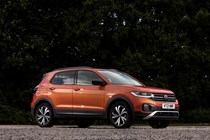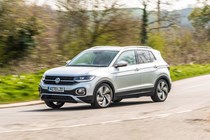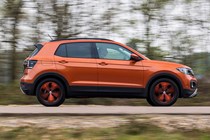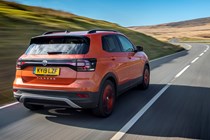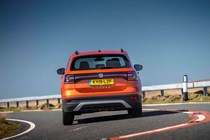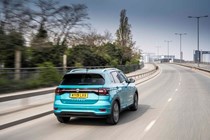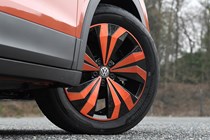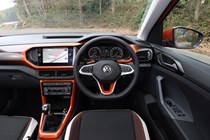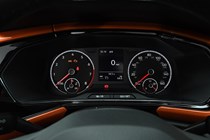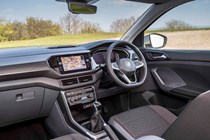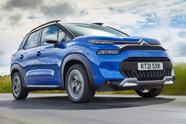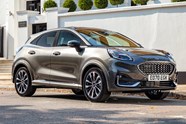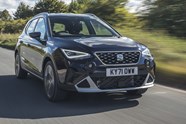
Volkswagen T-Cross review
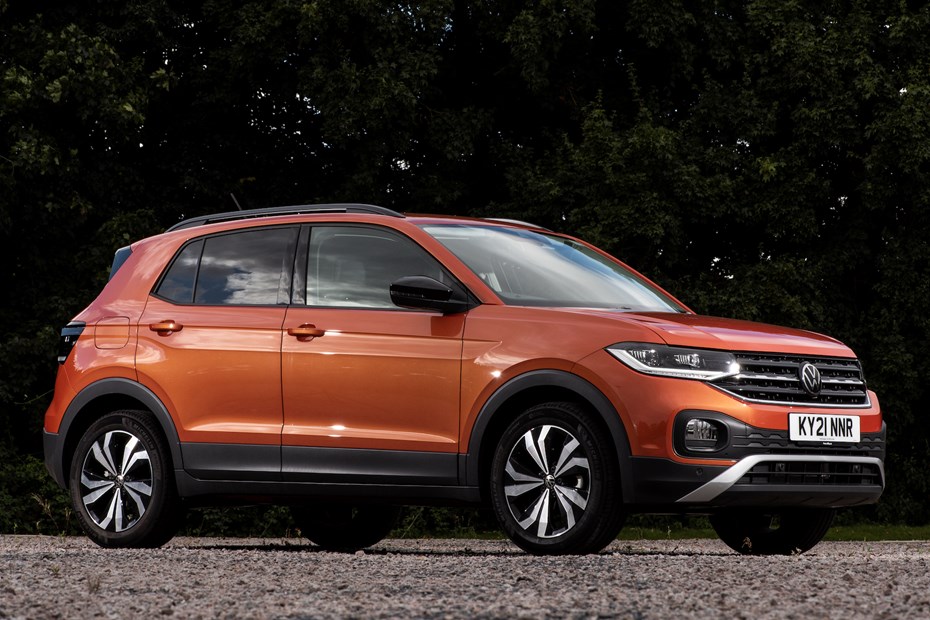
At a glance
| Price new | £23,755 - £31,405 |
|---|---|
| Used prices | £10,325 - £26,544 |
| Road tax cost | £190 |
| Insurance group | 8 - 18 |
Get an insurance quote with

|
|
| Fuel economy | 43.5 - 54.3 mpg |
| Range | 449 - 484 miles |
| Miles per pound | 6.4 - 7.4 |
| View full specs for a specific version | |
Available fuel types
Petrol
Diesel
Pros & cons
- Efficient, peppy range of engines
- Wealth of personalisation options
- Plenty of interior flexibility
- Interior plastics are hard and inexpensive
- Ride quality unsettled on larger wheels
- A little dull compared with many rivals
Volkswagen T-Cross SUV rivals
Overview
The Volkswagen T-Cross has established itself as a good value and popular small family car for those who want something chunkier than a Polo or Golf. It’s the entry-level SUV in Volkswagen’s range, fitting in below the popular T-Roc and bestselling Tiguan, with a choice of smaller engines and more basic equipment packages.
The T-Cross is based on the same underpinnings as the Polo and is closely related to the other Volkswagen Group cars, the SEAT Ibiza and its SUV stablemate the Arona as well as the popular (and brilliant) Skoda Kamiq.
As with so many small SUVs, the T-Cross is not a hardcore off-roader that will have you traversing tricky terrain. It makes no pretence of this – instead, it’s front-wheel drive-only, and is really a ruggedised small hatchback for families.
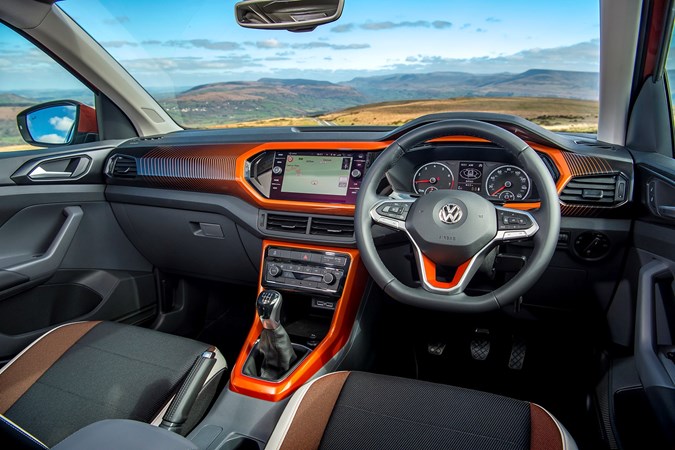
What’s it like inside?
No surprises that the Volkswagen T-Cross shares much of its interior with the closely-related Polo, which is both good and disappointing news. Positively, the switchgear feels pleasant and logical to operate, with well-damped actions that reassure you of the car’s potential longevity.
What’s more disappointing is the abundance of rigid, hollow-sounding plastics that line the interior, including the whole dashboard moulding. It might be acceptable in a city car at half the price, but given most T-Crosses will cost in excess of £20,000 it smacks of penny-pinching. A lack of fabric matching the seats on the door panels feels especially miserly.
It creates a stark contrast in a couple of respects, too. Those personalisation packs with a choice of orange or green panels across the dashboard give it a positive visual lift, making the cabin feel that bit more special. It’s a pity you have to pay extra to make that the case, though.
Similarly, the slick 8.0-inch infotainment touchscreen and sharp Active Info Display digital instrumentation pod both look glossy, high-tech and similarly at odds with some of those hard, shiny plastic surfaces.
Still, most touch points are better, particularly the thick-rimmed leather-wrapped steering wheel. Plus the commanding driving position is more like a traditional SUV. Compared with the SEAT Arona, you sit appreciably higher in the VW.
Practicality
For small families, the Volkswagen T-Cross will prove to be an eminently practical choice with ample room for four, along with plenty of in-cabin storage options. That sliding rear bench – standard on all T-Cross models – will prove useful for those with kids as little ones in child seats will be within close reach of adults in the front.
Although very similar in footprint to the Polo, the T-Cross’s extra height and elevated seating positions makes it much easier to get children into car seats without bending over so severely. With its compact dimensions – note that the R-Line is slightly longer at 4,235mm – the T-Cross is no trickier to park and drive in cities than a regular supermini. In fact, sitting slightly higher, makes it even easier in many regards.
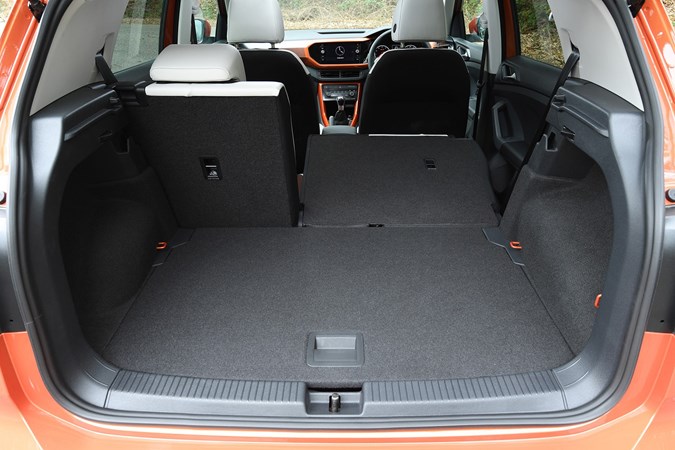
Boot space and storage
That extra height allows the T-Cross to have a deeper boot than the Polo. The sliding rear bench allows the boot volume to be increased without reducing the seat tally, although it can be split-folded 60:40 to increase the space available or to accommodate longer loads.
Boot size with the seats up ranges from 385-455 litres depending on where you position the variable-height boot floor.
Is it easy to park?
Good news here. It is easy to park. Visibility is good and it’s pretty square-shaped, meaning it’s easy to see the car’s extremities. Parking sensors and rear view cameras are on offer, but depend on which trim and or packs you choose.
Volkswagen T-Cross engines
The excellent 1.0-litre version comes in either 95hp (entry-level SE model only) or 110hp forms, while there’s a 1.5-litre TSI Evo power unit for the R-Line version.
We’re fans of Volkswagen’s three-cylinder 1.0-litre TSI turbocharged petrol engine and remain so when it’s powering the T-Cross. The 95hp version is fairly flexible, but performance on faster roads isn’t a strong point.
It’s fine around town but struggles a bit when loaded and pushing for motorway speeds, and is easily caught out by holding too high a gear around a corner, where it’s easy to fall into a rather cavernous power flat spot. Transmission-wise the 95hp engine only comes with a five-speed manual gearbox sending power to the front wheels. The manual ‘box doesn’t feel as slick as other VW Group cars we’ve driven, and the lever has a curiously long throw that blunts its sporting performance.
Delivering more pep – useful for T-Cross owners who regularly drive beyond slow-speed urban confines – is a 110hp edition of the 1.0-litre motor. Whether you choose the standard six-speed manual or the optional seven-speed DSG automatic, the on-road performance is identical.
Both gearbox options are commendable – the manual has a precise, well-damped shift action that feels cushioned between ratio changes, while the DSG feels smooth, eager and isn’t blighted by the slow take-off from standstill that affects some of the larger-engined models elsewhere in VW’s range. If your budget will stretch to it, go for the automatic, for an even more refined in-town driving experience.
We’ve yet to drive the 1.5-litre TSI Evo-engined T-Cross, but in other Volkswagen Group cars, we’ve found it to be smooth, powerful and remarkably economical when driven gently.
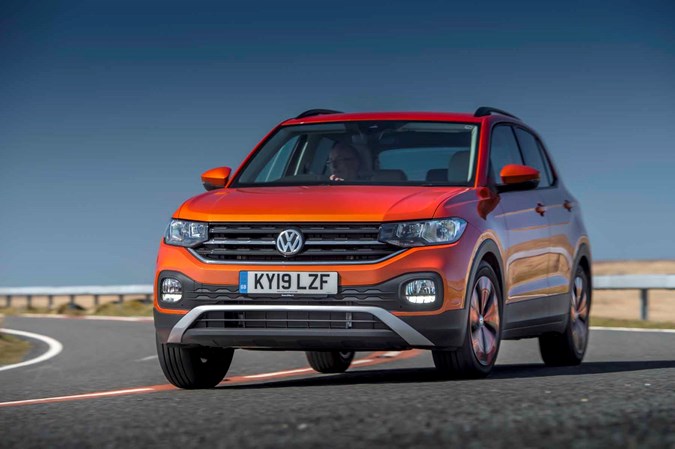
What’s it like to drive?
Buyers of SUVs with an urban-centric focus aren’t likely to be primarily interested in how well their car handles out on open, sweeping bends, but that’s not stopped Volkswagen from making the T-Cross a rather nice little thing to drive.
Not only does it feel more polished than any of its key rivals, despite the lofty driving position, we’d go as far to say it’s a more entertaining car to drive than the Polo it shares much of its underbody with. There’s – dare we say it – a bit of character on display here.
Cornering is particularly neat, the T-Cross faithfully tracking your intended line around faster corners with reassuring compliance. Only occasionally are you aware of the electronic stability systems kicking in when you start to slip, but that’s not how most of these VWs will be driven. That’s a pity as there’s a positive amount of steering feel to inform the driver about how much grip is at their disposal – it bodes well for higher-performance examples in the future.
Similarly, when you do fling it into some bends, bodyroll is kept in check, with little evidence of much lean as you press-on. Around town its compact dimensions and light steering make urban manoeuvres a doddle, while on motorways the T-Cross feels secure and planted, seemingly not swayed by gusts that momentarily push its rivals off-course.
Comfort
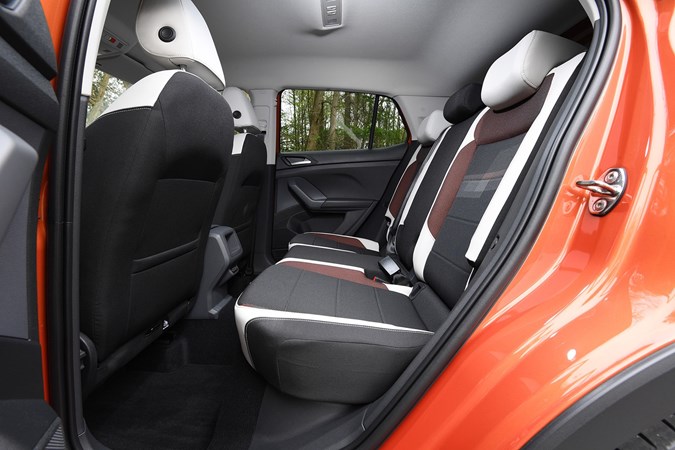
As with most small cars, five seatbelts are fitted in the Volkswagen T-Cross, but if you’re an adult sat in the middle of the rear bench you’ve drawn the short straw – particularly if you’re flanked by a pair of burly six-footers. Four-up, it’s pleasingly spacious with generous amounts of head- and legroom, plus that rear bench can be slid backwards and forwards, a useful feature for adults in the front reaching children in the back.
There’s a little hollowing of the rear seat’s outer cushions for comfort, although the backrest is flatter, while the front pair are supportive and comfy – but a tad more bolstering around the thighs wouldn’t go amiss. Comfort is further enhanced by the T-Cross’s compliant ride quality, which successfully irons out the sharpest of imperfections without inducing the kind of floaty sensation that often induces travel sickness.
It’s not perfect, though, and models tested with the larger 18-inch wheels displayed an occasional tendency to transmit the aftershocks of deeper road surface imperfections through to the cabin. We found it on the firmer side when driven on UK roads, often feeling a little jittery on cracked tarmac.
Safety
Euro NCAP tested the Volkswagen T-Cross for crash-testing purposes in late 2019 and gave it a clean bill of health. It was particularly impressive for its ability to protect the driver and everyone inside, with a strong passenger compartment. Those upfront are the most protected, with Euro NCAP saying the rear-seat occupants benefit from ‘adequate’ protection
SEL models and above also feature automatic lights and adaptive cruise control. One feature not available on any T-Cross derivative is Volkswagen’s 4Motion four-wheel drive system, despite its chunky SUV looks suggesting the contrary. Far better in colder months to switch to winter tyres for enhanced traction.
Running costs and mpg
There are only 1.0-litre petrol engines to choose from if you’re buying new. If you’re desperately after a diesel you could always buy used. However, we’d advise going for a petrol, not least because they’re so much nicer to drive.
Being based on VW’s small car platform with much commonality between various other Volkswagen-badged as well as Audi, SEAT and Skoda models, parts prices shouldn’t prove to be drastically expensive or tricky to source. Consequently, servicing won’t be too difficult or costly, either.
What models and trims are available?
The T-Cross line-up has a standard hierarchy comprising SE, Active, Black Edition, SEL and R-Line.
Connectivity technology is standard higher up the T-Cross range, including Android Auto and Apple CarPlay smartphone integration, plus up to four USB sockets to keep everyone’s devices topped-up.
Importantly, Volkswagen’s allowing buyers with a sense of adventure to personalise their T-Crosses with a suite of bold paint choices, with matching interior dashboard panels and alloy wheels.
Read on to find out how we rate the Volkswagen T-Cross.



